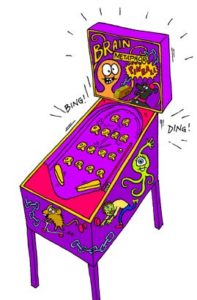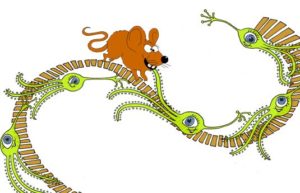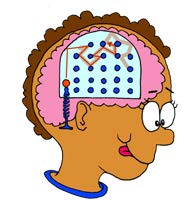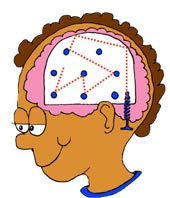Wouldn’t you love to know how to help your child learn better? More easily? With less frustration? During our online courses for adults, Learning How to Learn, parents in the group often ask us if we know how to help children learn. They figure if the simple techniques we teach—based on what we know from neuroscience—are good for adult learning, they might be good for their kids, too!

Metaphors—even seemingly silly ones—can be great tools for learning. Here, we’ll use the metaphor of the bouncing ball of a pinball machine as being akin to a thought bouncing
between “rubber bumpers”
(neurons) in your brain.
It turns out that kids do learn a lot like adults learn—even if kids sometimes seem to have the focusing abilities of a gnat. And there are some things, like languages, that they are even better at learning than adults.
Here are a few practical ideas on how to help your child make the most of their education without spending most of their time studying.
The Brain’s Two Different Learning Networks
Neuroscience has shown that the brain has two fundamentally different ways of thinking, which use two different sets of neural “circuits.” It’s sort of like having two different pinball tables in your brain—one where the rubber bumpers are close together, and the other where the bumpers are far apart.
When a child is focusing on what they are learning, they are using the equivalent of their brain’s “focused” pinball table, where the rubber bumpers are close together. This is great—that child is making progress in their studies as they concentrate.
Is your child supposed to multiply 74 × 35? Easy peasy—that is, if they already know how to do multiplication. Whether working the problem out on paper or doing it in their head, your child’s thoughts move smoothly along the neural “multiplication pathways” that they have already laid.
But let’s say your child is trying to figure out a problem that’s different from anything she’s ever worked on before. For example, she may know multiplication well, but division might be a whole new challenge. Working on her first division problems can seem like entering alien territory—she sees nothing she can understand, or that she even cares to understand!
This is not a problem only girls have—boys also have problems with math, although they don’t always want to admit it.
The reason your child is having trouble with the new concept is that she doesn’t have any neural pathways yet that can guide her as she solves the problem.
Notice what can happen in this potentially frustrating situation. Your child works away, trying various approaches to figure out what to do. If what she tries doesn’t work, she’ll start to feel more frustrated. And more frustrated.
What’s happening is she’s trapped in the focused mode, in patterns that just aren’t working! If she’s already at the end of her patience that day, she may end up feeling she must be stupid—and feeling math is stupid—and stomping off in disgust.
Children in a more tenacious mood might keep going but make no progress at all. This can be a critical point for your child—especially if she might know that her best friend Sarah gets her homework done in a flash. Enough of these kinds of episodes, and your child might decide she’s no good at math, (or music, or language studies—take your pick).
When your child feels this way, she may begin to shy away from the subject, which means she will begin to avoid the all-important practice needed to master it.
Get Through the Mental Roadblock
So how can you help? When your child has put in some good focused effort, but begins to feel well and truly stuck, she needs to shift to the broad pinball table of her brain’s diffuse mode. In this mode, her thoughts can range much more widely, to help her figure out what’s going on, so she can solve the problem.
To get your child to switch to the diffuse mode, tell her to try studying a different subject for a while, or better yet, take a break—throw a ball, play her favorite song (maybe even dance to it), or chat with friends. Active breaks where she can move around are best. Her brain will continue to work on the problem in the diffuse mode even though she is not aware of it.
Playing is good for getting the brain to work on a problem in the background. How great is that!
But the brain can only do this background diffuse work if your child has already worked hard to try to solve a problem. So, when she begins to feel super frustrated, (a little frustration is okay and even helpful—this technique is for serious, roadblock frustration), all your child needs to do is back away for a little while. This will let her diffuse mode work more broadly, processing the problem in the background of her brain.
After she’s taken a break, your child will be surprised to see that next time she returns to focusing on the problem, it will make more sense. In fact, she may wonder why she even struggled with the problem in the first place.
Another tried-and-true way to get a new insight into the problem is to sleep on it. The trick is for her to do a little last work on the problem just before going to sleep. (Of course, she shouldn’t wait until just before sleep to begin her work!) When she wakes up in the morning, she will see the problem more clearly—the diffuse mode even works while she is asleep.
Hitting the Learning Jackpot

Every child is different. Some children can focus on something difficult and grasp it quickly, without needing a diffuse mode break. But most kids need at least a time or
two of popping back and forth between focused and diffuse modes as they work to understand difficult ideas.
That’s perfectly normal. In fact, kids who take a while to grasp an idea can sometimes grasp that idea more deeply than the kids who seem to understand it all in a flash.
It takes time to lay the patterns of learning. We like to think of the neural pathways that make focused thinking easier as being like mouse paths in a neural forest.
The more often the thought—that is, the “mental mouse”—runs along that path, the thicker and easier that path will be for your mouse to follow. That’s why, once you’ve understood and practiced a concept often, it’s easy to focus and work with it.
So, take the time to learn a little about how we learn, and you’ll be surprised at how much you can help your child!
Barbara Oakley, PhD, is a professor of engineering at Oakland University in Rochester, Mich., and Ramón y Cajal Distiguished Scholar of Global Digital Learning at McMaster University. Terrence Sejnowski, PhD, is the Francis Crick Professor at The Salk Institute for Biological Studies, where he also directs the Computational Neurobiology Laboratory. They are the authors of Learning How to Learn: How to Succeed in School Without Spending All Your Time Studying; A Guide for Kids and Teens.







